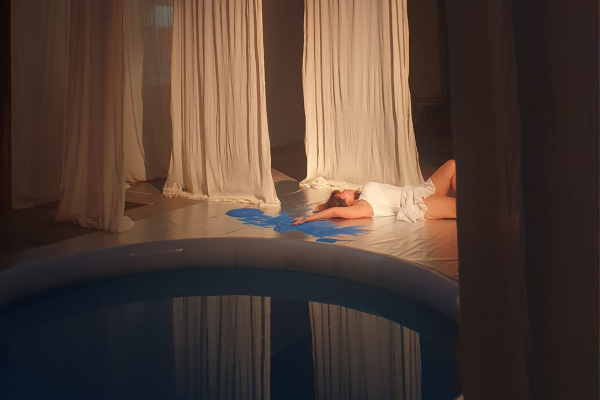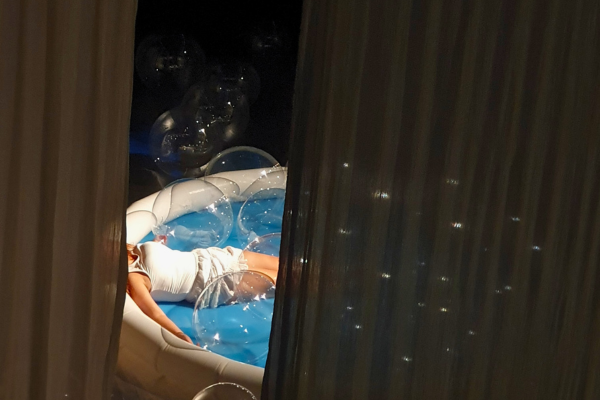Fluid Whispers: A First-Person Account

It is a summer's evening. The night is thick with the smell of warm tarmac. As I walk through the two-hundred-year-old doors of Fabrica, the air cools. My eyes adjust to the dark; I see thick white drapes hanging from the ceiling. In the centre of the drapes, laying on a silver floor, is a shallow white pool filled with vivid blue water; surrounding it are crop circles of blue sand, and sitting on the floor, partially hidden by the white veils, is a woman with red hair dressed all in white.
I walk around the panorama to get a better view, but no matter where I stand, some elements are hidden from view. Then, into the silence, the sound of water droplets resonates off the high ceilings, and, slowly, music blends with the droplets, creating a soundscape that makes me think of bathing in river—with all the magic and trepidation that entails. The music breathes life into the previously still woman in white. She begins her life playing in a warm, yellow light that pierces through the dark and cool of the room. The drapes, music, and light give the impression of watching a fairy come to life in an enchanted forest.
Like a child, the woman explores the boundaries of her surroundings. She makes pictures with the sand; she plays with beach-ball-sized bubbles that rain down on her; she even crosses the threshold and bathes, fully clothed, in the pool of blue.
For an hour, we watch her dance, play, learn and grow from our vantage point in the darkness. However, at the end, once she and the audience have explored the world, the childish innocence of the piece comes to a close in one irrevocable moment. The music stops, the light fades, and the woman in white, the fairy in the woods, soaked through, steps out of the pool, takes up a pair of scissors found along the way, and cuts into one of the expensive drapes. She cuts off six feet of the scared cloth, wraps it around her, walks out of the safe world that confined her, into the darkness, and the performance ends in a grown-up, all-too-real stillness.

'Fluid Whispers', the performance just described, is part of Beiyi Wang's Making Space residency at Fabrica. Making Space is an initiative that provides artists access to our iconic venue for a week to develop new and innovative ideas. Wang's team comprises a dancer (the woman in white), two architects (who designed the layout), and a whole team of artists who helped develop and create the piece.
In the Artist Q&A, the team explains that, for them, the performance is about the ritual and ceremony of bathing, and hopes to highlight the importance of these daily rituals.
They specifically chose Fabrica (a de-ordained church) to explore the undercurrents of spirituality and baptism flowing through the piece. They chose bathing as a subject of art to elevate it from the ordinary and to encourage people to see it as a healing ritual—a magical place that transcends the mundanity of life, and quiets the incessant voices of the mind.
The woman in white, the dancer, explained that we can use bathing 'to create our own art.' She goes on to say: 'When you are letting the water flow on your body, you can feel its touch and you can learn to love yourself.' When asked about art, she concludes: 'Art makes us love ourselves and the artist as well.'
Read our interview with Beiyi Wang here.
--
Stay up to date with our artist performances and other events on our mailing list.
Words by summer Marketing and Communications intern Timothy Woodbridge.